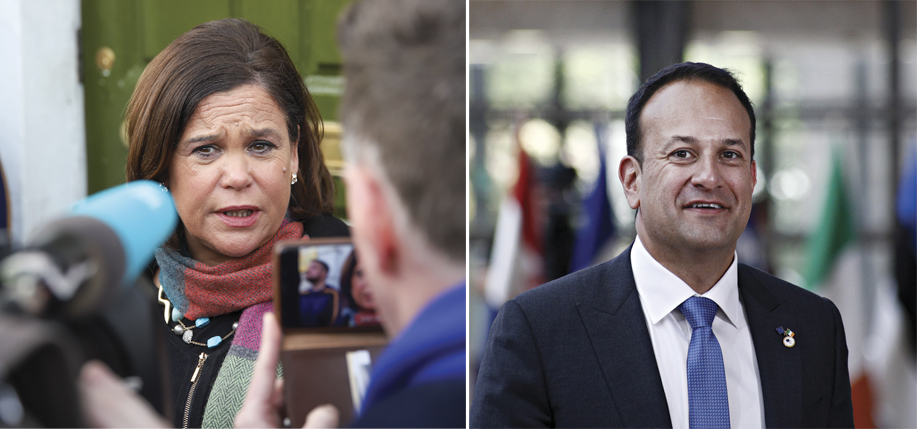The Irish people went to the polls on February 8 to elect a new government. Almost a month later, that government has yet to be formed. Why is this and what does it mean?
In order to form a government in Ireland, a party or coalition of parties must have at least 80 seats. In the recent election, Fianna Fáil narrowly emerged as the largest party with 38 seats. Sinn Féin were right behind them with 37 and Fine Gael – the party that has been in power since 2011 – got 35.
This almost three-way tie, with each party falling far short of the required minimum, means the unthinkable is suddenly possible in Ireland.
Ever since the foundation of the State, every election has resulted in the victory of one of the two parties that fought on either side of the Irish Civil War: Fianna Fáil or Fine Gael.
Faith in Fianna Fáil began to wane following the party’s mismanagement of the Celtic Tiger boom and the country’s resultant crash into recession. When Ireland was forced to cede some of its sovereign powers for financial aid from the International Monetary Fund, the European Central Bank, and the European Commission in 2008, Fianna Fáil was voted out of power.
Following the traditional pendulum swing of Irish history, they were succeeded by Fine Gael, who set about implementing the austerity measures that had been agreed as part of the bailout.
Those measures are still being felt in Ireland today, especially by those most vulnerable. In the public health system, sick people are being treated on trollies in overcrowded corridors due to lack of beds and others are waiting years for medical services such as MRI scans and hip replacements.
Not enough houses have been built since the crash in 2008 and the cost of housing has spiraled upwards as a result. The average cost of renting in Dublin is now €2,000 a month, which prices a growing number of people out of the market. Over 10,000 people are living in emergency accommodation provided by the State so that they and their families don’t have to sleep on the streets.
During the election campaign, Sinn Féin offered concrete policies that addressed the concerns of those who have been left behind by Ireland’s economic recovery. That’s why people broke with the voting traditions of the past. They wanted change.
The question now is: are they going to get it? Fianna Fáil has ruled out going into government with Sinn Féin because of the party’s alleged ties with the Provisional IRA in Northern Ireland.
This is a valid concern that is shared by Ireland’s police force. An Garda Síochána has said that it believes that Sinn Féin answers to the Provisional IRA’s so-called army council, members of whom are involved in illegal activity. This would create an obvious (even dangerous) conflict of interest if Sinn Féin were to have a say in Irish security decisions.
Fine Gael is also unlikely to enter government with Sinn Féin.
There is a third alternative, and that is Fianna Fáil and Fine Gael going into government together. That would mark an end to the civil war politics that have held sway in Ireland for almost a century. However, there is little public appetite for such a coalition.
Sinn Féin has maintained its election footing since the election. Leadership has held rallies in Dublin, Cork, and Newry in Northern Ireland in the past month, ostensibly to listen to voters. Some have interpreted these rallies differently, seeing them as an intimidating show of force from a party with suspected paramilitary associations.
Such tactics appear to be working. A Behaviour and Attitudes Poll carried out between February 17 and 25 saw support for the party rise by ten percent since the election. The support enjoyed by Fianna Fáil and Fine Gael has fallen by two percent and three percent during the same period.
Sinn Féin’s political clout south of the border could have an impact on things other than the formation of the next Irish government. If the party gains power north and south, it could hasten a referendum on Irish unity.
There are already signs that the public is ready to discuss reunification. The Economist ran a cover story on the issue in February, calling on politicians in the Republic and Britain to start talking about the possibility. In the general election that took place in the U.K. in December, nationalist parties won more Westminster seats than unionist parties for the first time since partition. And in a poll carried out by RTÉ on election night in February, 57 percent of Irish people were in favor of a unification poll happening in the next five years.
As I write, talks about government formation are still ongoing and could continue for up to three months, unless another election is held in the interim. All that is certain for now is that the Irish electorate has made a break with the past. Ireland is no longer a two-party state and Sinn Féin represents a new political force in the country. Change is coming to Ireland, north and south. ♦


Leave a Reply